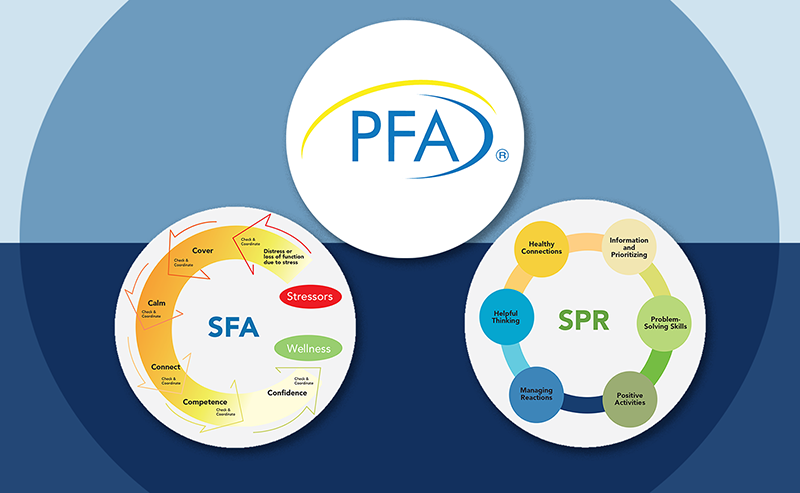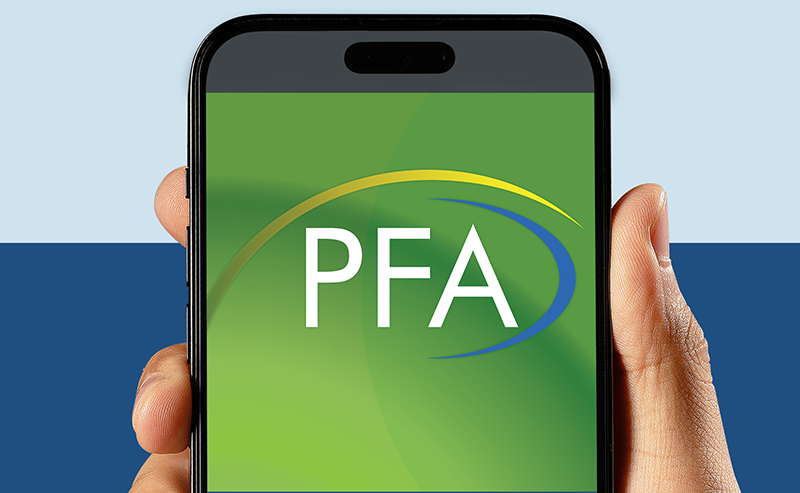PTSD: National Center for PTSD
The Impact of Disaster Events on Mental Health
The Impact of Disaster Events on Mental Health
Almost everyone will experience stress reactions in the aftermath of disaster events, which can be natural or human-caused disasters, mass violence, or public health emergencies like disease outbreaks, chemical spills, or radiation emergencies. For most people, these reactions will gradually decrease over time, but some affected individuals—especially those with specific risk factors—may experience longer-term or severe responses.
Common Reactions
Those affected by disaster events exhibit a wide variety of psychological, behavioral, physical, and emotional reactions. The most common mental health diagnoses reported in research samples are posttraumatic stress disorder (PTSD), depression, anxiety, acute stress disorder, adjustment disorder, and complicated grief. Negative emotions such as anger or fear, perceived stress, physical health problems/somatic concerns, and poor sleep quality are also reported in disaster research (1-8). These reactions may be relatively common in the 6-12-month period after a disaster (9) and have been shown across a range of events.
Scale of Mental Health Reactions
The impact of disaster events on mental health can vary. The proportion of those affected by disasters who develop chronic long-term problems is generally less than 10%, and rarely exceeds 30% (6-8). Norris and Elrod's comprehensive reviews of disaster research document the magnitude of effects for 225 samples of people affected by 132 distinct events (4,5). Moderate effects—increased or prolonged stress, but little enduring psychopathology—were present in 50% of the samples. For 24% and 17% of the samples, respectively, the effects were severe or very severe. Severe effects were defined as a high (25% - 49%) prevalence of clinically-significant distress, while prevalence of clinically-significant distress of 50% or higher was indicative of very severe post-event effects. Large-scale, catastrophic natural disasters, human-caused disasters, and mass violence events are generally associated with longer lasting and higher rates of mental health problems as compared to more common natural disasters.
Time Frame for Reactions
Research shows that a significant proportion of those exposed to disaster or mass violence will experience immediate intense reactions, which decline over time (e.g. 10-12). Acute distress reactions within the first few weeks should not necessarily be regarded as pathological. Most affected individuals are likely to simply need support and provision of resources in the early phases post-event, rather than traditional diagnosis and clinical treatment. Therefore, screening and identification of those who may need services requires some sensitivity.
In longitudinal disaster studies, stress reactions and symptoms are most likely to be apparent in the year following the disaster, with the majority of those studied showing improvement with time (4). For instance, an analysis of longitudinal studies of two devastating events—a widespread flood in Mexico and the 9/11 terrorist attacks in New York—found seven distinct trajectories of post-event functioning. Up to 50% of those affected showed resistance, never exhibiting more than three PTSD symptoms. About 10% to 32% showed resilience; they had mild symptoms that improved rapidly. Much smaller percentages had severe symptoms that were maintained or that increased over time (10). In another 10-year study of a major fireworks disaster, around 4-6% of affected individuals suffered from severe persistent PTSD symptomatology, depression, anxiety and sleep problems. Ten years after the disaster, 16.7% had severe PTSD symptoms (13).
Those individuals with high exposure to the event, who lack of social support, or experience ongoing adversity are more likely to face enduring post-disaster distress and symptomatology (10, 11, 14-19). This is true for both adults and children.
Summary
A wide variety of mental health reactions have been reported in studies with people affected by disaster events. The scale of impact varies across events, with the majority of studies reporting moderate effects that fade over time. However, those most strongly exposed—as well as those who face ongoing adversities—are at risk for long-term problems, even up to 10 years after the event.
References
- Morganstein, J. C., West, J. C., Huff, L. A., Flynn, B. W., Fullerton, C. S., Benedek, D. M., & Ursano, R. J. (2016). Psychosocial responses to disaster and exposures: Distress reactions, health risk behavior, and mental disorders. In J. Shigemura & R. Chhem (Eds.) Mental Health and Social Issues Following a Nuclear Accident (pp. 99-117). Springer.
- Lowe, S. R., & Galea, S. (2015). The mental health consequences of mass shootings. Trauma, Violence, & Abuse, 18(1),62-82. https://doi.org/10.1177/1524838015591572
- Goldmann, E., & Galea, S. (2014). Mental health consequences of disasters. Annual review of Public Health, 35, 169-183. https://doi.org/10.116/annurev-publhealth-02013-182435
- Norris, F. H. & Elrod, C. L. (2006). Psychosocial consequences of disasters: A review of past research. In F. H. Norris, M. J. Friedman, & P. J. Watson (Eds.) Methods for disaster mental health research (pp. 20-42). Guilford Press.
- Norris, F. H. (2005). Range, magnitude, and duration of the effects of disasters on mental health: Review update 2005. Research Education Disaster Mental Health, 1-23.
- Schlenger, W. E., Caddell, J. M., Ebert, L., Jordan, B. K., Rourke, K. M., Wilson, D., Thalji, L., Dennis, M., Fairbank, J. A. & Kulka, R. A. (2002). Psychological reactions to terrorist attacks: Findings from the National Study of Americans' Reactions to September 11. JAMA, 288(5), 581-588. https://doi.org/10.1001/jama.288.5.581
- Kristensen, P., Weisæth, L., & Heir, T. (2012). Bereavement and mental health after sudden and violent losses: A review. Psychiatry, 75(1), 76-97. https://doi.org/10.1521/psyc.2012.75.1.76
- Miguel-Tobal, J. J., Cano-Vindel, A., Gonzalez-Ordi, H., Iruarrizaga, I., Rudenstine, S., Vlahov, D., & Galea, S. (2006). PTSD and depression after the Madrid March 11 train bombings. Journal of Traumatic Stress, 19(1), 69-80. https://doi.org/10.1002/jts.20091
- Pietrzak, R. H., Goldstein, R. B., Southwick, S. M., & Grant, B. F. (2012). Physical health conditions associated with posttraumatic stress disorder in US older adults: Results from wave 2 of the National Epidemiologic Survey on Alcohol and Related Conditions. Journal of the American Geriatrics Society, 60(2), 296-303. https://doi.org/10.1111/j.1532-5415.2011.078.x
- Norris, F. H., Tracy, M., & Galea, S. (2009). Looking for resilience: Understanding the longitudinal trajectories of responses to stress. Social Science & Medicine, 68(12), 2190-2198. https://doi.org/10.1016/j.socscimed.2009.03.03
- Bonanno, G. A., Brewin, C. R., Kaniasty, K., & La Greca, A. M, (2010). Weighing the costs of disaster: Consequences, risks, and resilience in individuals, families, and communities. Psychological Science in the Public Interest, 11(1), 1-49. https://doi.org/10.1177/1529100610387086
- Galea, S., Vlahov, D., Resnick, H., Ahern, J., Susser, E., Gold, J., Bucuvalas, M. & Kilpatrick, D. (2003). Trends of probable post-traumatic stress disorder in New York City after the September 11 terrorist attacks. American Journal of Epidemiology, 158(6), 514-524. https://doi.org/10.1093/aje/kwg187
- Smid, G. E., van der Velden, P. G., Gersons, B. P., & Kleber, R. J. (2012). Late-onset posttraumatic stress disorder following a disaster: A longitudinal study. Psychological Trauma: Theory, Research, Practice, and Policy, 4(3), 312-322. https://doi.org/10.1037/a0023868
- Cukor, J., Wyka, K., Mello, B., Olden, M., Jayasinghe, N., Roberts, J., Giosan, C., Crane, M. & Difede, J. (2011). The longitudinal course of PTSD among disaster workers deployed to the World Trade Center following the attacks of September 11th. Journal of traumatic stress, 24(5), 506-514. https://doi.org/10.1002/jts20672
- Cherry, K. E., Sampson, L., Galea, S., Marks, L. D., Nezat, P. F., Baudoin, K. H., & Lyon, B. A. (2017). Optimism and hope after multiple disasters: relationships to health-related quality of life. Journal of Loss and Trauma, 22(1), 61-76. https://doi.org/10.1080/15325024.201.1187047
- Cerdá, M., Bordelois, P. M., Galea, S., Norris, F., Tracy, M., & Koenen, K. C. (2013). The course of posttraumatic stress symptoms and functional impairment following a disaster: what is the lasting influence of acute versus ongoing traumatic events and stressors? Social Psychiatry and Psychiatric Epidemiology, 48(3), 385-395. https://doi.org/10.1007/s00127-012-0560-3
- Thordardottir, E. B., Valdimarsdottir, U. A., Hansdottir, I., Resnick, H., Shipherd, J. C., & Gudmundsdottir, B. (2015). Posttraumatic stress and other health consequences of catastrophic avalanches: A 16-year follow-up of survivors. Journal of Anxiety Disorders, 32, 103-111. https://doi.org/10.1016/janxdis.2015.03.005
- Velden, P. G., Wong, A., Boshuizen, H. C., & Grievink, L. (2013). Persistent mental health disturbances during the 10 years after a disaster: Four-wave longitudinal comparative study. Psychiatry and Clinical Neurosciences, 67(2), 110-118. https://doi.org/10.1111/pcn.12022
- La Greca, A. M., Lai, B. S., Llabre, M. M., Silverman, W. K., Vernberg, E. M., & Prinstein, M. J. (2013). Children's postdisaster trajectories of PTS symptoms: Predicting chronic distress. Child & Youth Care Forum 42(4), 351-369. https://doi.org/10.1007/s10566-013-9206-1
You May Also Be Interested In


























